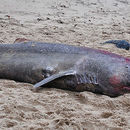Diagnostic Description
(
englanti
)
tarjonnut Fishbase
A gigantic, heavily-bodied dogfish shark with a moderately long, rounded snout and small, low dorsal fins; lower caudal lobe long; upper jaw with small single-cusped teeth and lower jaw with moderate-sized, bent-cusped, slicing teeth (Ref. 5578). Medium grey or brown in color, sometimes with transverse dark bands or small light spots (Ref. 5578).
- lisenssi
- cc-by-nc
- tekijänoikeus
- FishBase
- Recorder
- Cristina V. Garilao
Life Cycle
(
englanti
)
tarjonnut Fishbase
Ovoviviparous (Ref. 247). Distinct pairing with embrace (Ref. 205).
- lisenssi
- cc-by-nc
- tekijänoikeus
- FishBase
- Recorder
- Cristina V. Garilao
Migration
(
englanti
)
tarjonnut Fishbase
Oceanodromous. Migrating within oceans typically between spawning and different feeding areas, as tunas do. Migrations should be cyclical and predictable and cover more than 100 km.
- lisenssi
- cc-by-nc
- tekijänoikeus
- FishBase
- Recorder
- Kent E. Carpenter
Morphology
(
englanti
)
tarjonnut Fishbase
Dorsal spines (total): 0; Dorsal soft rays (total): 0; Analspines: 0; Analsoft rays: 0; Vertebrae: 41 - 44
- lisenssi
- cc-by-nc
- tekijänoikeus
- FishBase
- Recorder
- Cristina V. Garilao
Trophic Strategy
(
englanti
)
tarjonnut Fishbase
Reported abundant on continental and insular shelves and upper slopes down to at least 1,200 m (Ref. 247) and recorded to as deep as 2,200 m (Ref. 55584) on theh Mid-Atlantic Ridge (Ref. 119696). Epibenthic-pelagic (Ref. 58426). In the Arctic and boreal Atlantic, it occurs inshore in the intertidal and at the surface in shallow bays and river mouths during colder months, retreating to depths of 180-550 m when the temperature rises (Ref. 247). Feeds on pelagic and bottom fishes (herring, spiny eels, Atlantic salmon, Arctic char, smelt, gadoids including cod, ling, pollock and haddock, capelin, redfish, sculpins, lumpfish, Atlantic halibut, Greenland halibut, wolf-fish, redfish (Sebastes) and skates and their egg cases (Ref. 247, 5951), marine mammals, seals (common prey and possibly taken alive) and small cetaceans (most probably mostly as carrion), sea birds, squids, crabs, amphipods, marine snails, brittle stars, sea urchins, and jellyfish. Known to voraciously devour carrion and offal from whaling, sealing and fishing operations (Ref. 247, 58240).
- lisenssi
- cc-by-nc
- tekijänoikeus
- FishBase
Biology
(
englanti
)
tarjonnut Fishbase
Found on continental and insular shelves and upper slopes down to at least 1,200 m (Ref. 247) and to as deep as 2,200 m (Ref. 55584). Epibenthic-pelagic (Ref. 58426). In the Arctic and boreal Atlantic, it occurs inshore in the intertidal and at the surface in shallow bays and river mouths during colder months, retreating to depths of 180-550 m when the temperature rises (Ref. 247). Reported to be found in temperatures from -1.8° to 17.2°C but commonly below 5°C at with salinity range of 29.4-35.5. It is capable of undertaking long migrations (Ref. 119696). Feeds on pelagic and bottom fishes (herring, Atlantic salmon, Arctic char, capelin, redfish, sculpins, lumpfish, cod, haddock, Atlantic halibut, Greenland halibut and skates (Ref. 5951)), sharks and skates (Ref. 5578), seals and small cetaceans, sea birds, squids, crabs, amphipods, marine snails, brittle stars, sea urchins, and jellyfish (Ref. 247, 58240). Radiocarbon dating of eye lens nuclei from 28 caught female Greenland sharks (81-502 cm TL) revealed a life span of at least 272 years, the oldest being nearly 400 years; age of sexual maturity is about 150 years. This large species is slow-growing (Ref. 110949). Petromyzon marinus was reported to have been attached to S. microcephalus (Ref. 58185). Ovoviviparous (Ref. 205). Utilized fresh and dried for human and sled-dog food (flesh is said to be toxic when fresh); Inuit also used the skin to make boots, and the sharp lower dental bands as knives for cutting hair (Ref. 247). A very sluggish shark (Ref. 28609). Reports in literature of lengths exceeding 640 cm TL (e.g. up to 730 cm TL in Ref. 247) remain unverified. Common length 244-427 cm TL (Ref. 119696).
- lisenssi
- cc-by-nc
- tekijänoikeus
- FishBase
- Recorder
- Kent E. Carpenter
Importance
(
englanti
)
tarjonnut Fishbase
fisheries: minor commercial; gamefish: yes; price category: low; price reliability: reliable: based on ex-vessel price for this species
- lisenssi
- cc-by-nc
- tekijänoikeus
- FishBase
- Recorder
- Kent E. Carpenter

